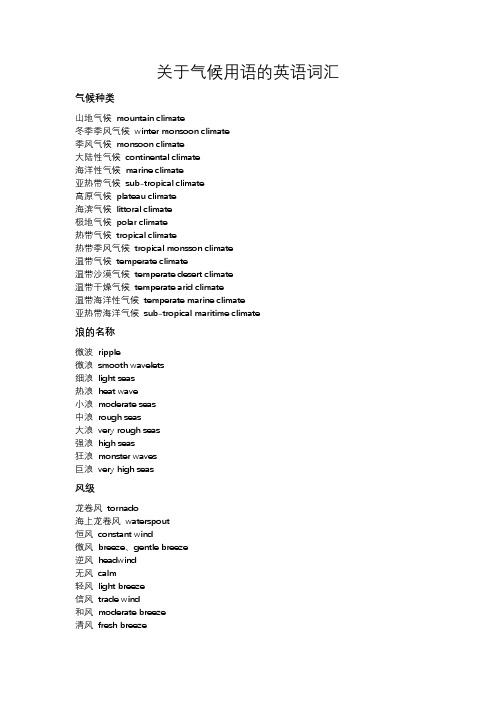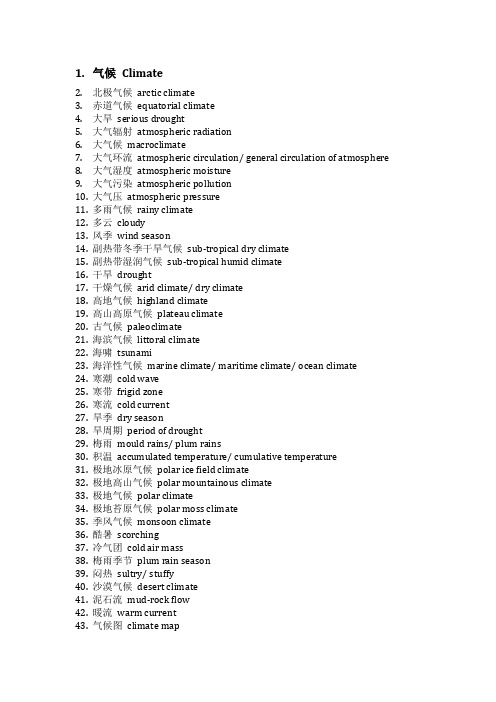各种气候带英文说法
关于气候的英语词汇

山地气候 mountain climate冬季季风气候 winter monsoon climate季风气候 monsoon climate大陆性气候 continental climate海洋性气候 marine climate亚热带气候 sub-tropical climate高原气候 plateau climate海滨气候 littoral climate极地气候 polar climate热带气候 tropical climate热带季风气候 tropical monsson climate温带气候 temperate climate温带沙漠气候 temperate desert climate温带干燥气候 temperate arid climate温带海洋性气候 temperate marine climate亚热带海洋气候 sub-tropical maritime climate 浪的名称微波 ripple微浪 smooth wavelets细浪 light seas热浪 heat wave小浪 moderate seas中浪 rough seas大浪 very rough seas强浪 high seas狂浪 monster waves巨浪 very high seas风级龙卷风 tornado海上龙卷风 waterspout恒风 constant wind微风 breeze、gentle breeze逆风 headwind无风 calm轻风 light breeze信风 trade wind和风 moderate breeze清风 fresh breeze大风 gale强风 strong breeze飓风 hurricane旋风 cyclone台风 typhoon大浪 very rough seas冷峰 cold front顺风 favorable wind强浪 high seas低气压 low-pressure闷热天气 muggy weather巨浪 very high seas雨量 rainfall雹 hail狂浪 monster waves东北风 northeaster雷 thunder自然灾害沙尘暴 sandstorm东风 east wind滂沱大雨 downpour暴风 tormy windy大风雪 blizzard暴风雪 snowstorm大风雪 blizzard火山地震 volcanic earthquake 炎热 scorching heat暖锋 warm front海啸 tidal wave风眼 eye of a storm零度 zero山崩 landslide零度以下 subzero。
汉英口译-环境保护词汇

汉英口译分类词汇--环境保护词汇(1)21世纪议程Agenda 21 (the international plan of action adopted by governments in 1992 in Rio de Janeiro Brazil(巴西里约), - provides the global consensus on the road map towards sustainable development)世界环境日World Environment Day (June 5th each year)世界环境日主题World Environment Day Themes环境千年-行动起来吧!(2000)The Environment Millennium - Time to Act!拯救地球就是拯救未来!(1999)Our Earth - Our Future - Just Save It!为了地球上的生命-拯救我们的海洋!(1998)For Life on Earth - Save Our Seas!为了地球上的生命(1997)For Life on Earth我们的地球、居住地、家园(1996)Our Earth, Our Habitat, Our Home国际生物多样性日International Biodiversity Day (29 December)世界水日World Water Day (22 March)世界气象日World Meteorological Day(23 March)世界海洋日World Oceans Day (8 June )联合国环境与发展大会(环发大会)United Nations Conference on Environment and Development (UNCED)环发大会首脑会议Summit Session of UNCED 联合国环境规划署United Nations Environment Programs (UNEP)2000年全球环境展望报告GEO-2000;Global Environmental Outlook 2000入选"全球500佳奖" be elected to the rank of Global 500 Roll of Honor联合国人类居住中心UN Center for Human Settlements (UNCHS)改善人类居住环境最佳范例奖Best Practices in Human Settlements Improvement人与生物圈方案Man and Biosphere (MAB)Programme (UNESCO)中国21世纪议程China's Agenda 21中国生物多样性保护行动计划China Biological Diversity Protection Action Plan中国跨世纪绿色工程规划China Trans-Century Green Project Plan国家环境保护总局State Environmental Protection Administration (SEPA)中国环保基本方针China's guiding principles for environmental protection坚持环境保护基本国策adhere to the basic state policy of environmental protection推行可持续发展战略pursue the strategy of sustainable development贯彻经济建设、城乡建设、环境建设同步规划、同步实施、同步发展(三同步)的方针carry out a strategy of synchronized planning, implementation and development in terms of economic and urban and rural development and environmental protection (the "three synchronizes" principle)促进经济体制和经济增长方式的转变promote fundamental shifts in the economic system and mode of economic growth实现经济效益、社会效益和环境效益的统一bring about harmony of economic returns and contribution to society and environmental protection 中国环保基本政策the basic policies of China's environmental protection预防为主、防治结合的政策policy of prevention in the first place and integrating prevention with control污染者负担的政策"the-polluters-pay" policy强化环境管理的政策policy of tightening up environmental management一控双达标政策policy of "One Order, Two Goals":"一控":12种工业污染物的排放量控制在国家规定的排放总量The total discharge of 12 industrial pollutants in China by the end of 2000 shall not exceed the total amount mandated by the central government.;"双达标":1. 到2000年底,全国所有的工业污染源要达到国家或地方规定的污染物排放标准The discharge of industrial pollutants should meet both national and local standards by the end of 2000. 2. 到2000年底,47个重点城市的空气和地面水达到国家规定的环境质量标准 2. Air and surface water quality in all urban districts in 47 major cities should meet related national standards by the end of 2000.对新项目实行环境影响评估conduct environmental impact assessments (EIA)on start-up projects提高全民环保意识raise environmental awareness amongst the general public查处违反环保法规案件investigate and punish acts of violating laws and regulations on environmental protection环保执法检查environmental protection law enforcement inspection限期治理undertake treatment within a prescribed limit of time中国已加入的国际公约international conventions into which China has accessed控制危险废物越境转移及其处置的巴塞尔公约Basel Convention on the Control of Transboundary Movements of Hazardous Wastes and Their Disposal 关于消耗臭氧层物质的蒙特利尔议定书Montreal Protocol on Substances that Deplete the Ozone Layer生物多样性公约Convention on Biological Diversity防治荒漠化国际公约Convention to Combat Desertification气候变化框架公约United Nations Framework Convention on Climate Change生态示范区eco-demonstration region;environment-friendly region国家级生态示范区(珠海)Nationally Designated Eco-Demonstration Region国家级园林城市Nationally Designated Garden City放射性废料积存accumulation of radioactive waste 有机污染物organic pollutants氰化物、砷、汞排放cyanide, arsenic, mercury discharged铅、镉、六价铬lead, cadmium, sexivalent chromium 城市垃圾无害化处理率decontamination rate of urban refuse垃圾填埋场refuse landfill垃圾焚化厂refuse incinerator防止过度利用森林protect forests from overexploitation森林砍伐率rate of deforestation水土流失water and soil erosion土壤盐碱化soil alkalization农药残留pesticide residue水土保持conservation of water and soil生态农业environment-friendly agriculture; eco-agriculture水资源保护区water resource conservation zone海水淡化sea water desalinization保护珊瑚礁、红树林和渔业资源protect coral reefs, mangrove and fishing resource绿化祖国turn the country green全民义务植树日National Tree-Planting Day造林工程afforestation project绿化面积afforested areas; greening space森林覆盖率forest coverage防风林wind breaks (防沙林sand breaks)速生林fast-growing trees降低资源消耗率slow down the rate of resource degradation开发可再生资源develop renewable resources环保产品environment-friendly products自然保护区nature reserve野生动植物wild fauna and flora保护生存环境conserve natural habitats濒危野生动物endangered wildlife珍稀濒危物种繁育基地rare and endangered species breeding center自然生态系统natural ecosystems防止沙漠化(治沙、抗沙)desertification环境负荷carrying capacity of environment三废综合利用multipurpose use of three types of wastes先天与后天,遗传与环境nature-nurture美化环境landscaping design for environmental purposes防止沿海地带不可逆转恶化protect coastal zones from irreversible degradation环境恶化environmental degradation城市化失控uncontrolled urbanization温饱型农业subsistence agriculture贫困的恶性循环vicious cycle of poverty大气监测系统atmospheric monitoring system空气污染浓度air pollution concentration酸雨、越境空气污染acid rain and transboundary air pollution二氧化硫排放sulfur dioxide (SO2) emissions悬浮颗粒物suspended particles工业粉尘排放industrial dust discharged烟尘排放soot emissions二氧化氮nitrate dioxide (NO2)矿物燃料(煤、石油、天然气)fossil fuels: coal, oil,and natural gas清洁能源clean energy汽车尾气排放motor vehicle exhaust尾气净化器exhaust purifier无铅汽油lead-free gasoline天然气汽车gas-fueled vehicles电动汽车cell-driven vehicles; battery cars氯氟烃CFCs温室效应greenhouse effect厄尔尼诺南徊ENSO (El Nino Southern Oscillation) 噪音noise (分贝db; decibel)化学需氧量(衡量水污染程度的一个指标)COD;chemical oxygen demand生物需氧量BOD; biological oxygen demand工业废水处理率treatment rate of industrial effluents 城市污水处理率treatment rate of domestic sewage 集中处理厂centralized treatment plant红潮red tide (rapid propagation of sea algae英语"气象"用语表达法1、气候种类山地气候mountain climate 恒风constant wind 微风breeze冬季季风气候winter monsoon climate 逆风headwind 台风typhoon季风气候monsoon climate 高气压high-pressure 锋面frontal edge亚热带气候sub-tropical climate 气团air mass 热浪heat wave高原气候plateau climate 闪电lightning 雾fog 海滨气候littoral climate 凉cool 霜frost极地气候polar climate 雪堆snowdrift 露dew 热带气候tropical climate 寒冷chilly 3、风的名称温带沙漠气候temperate desert climate 间歇雨intermittent rain 无风calm温带干燥气候temperate arid climate 大雨heavy rain 轻风light breeze热带季风气候tropical monsson climate 信风trade wind 微风gentle breeze大陆气候continental climate 天气预报weather forecast 和风moderate breeze沙漠气候desert climate 甘霖welcome rain 清风fresh breeze沿海气候coastal climate 冰柱icicle 强风strong breeze高地气候highland climate 西北风northwester 疾风near gale海洋气候marine climate 地形雨local rains 大风gale森林气候forest climate 狂风squall 烈风strong gale温带气候temperate climate 雨季rainy season 狂风storm湿润气候humid climate 雨点raindrops 暴风violent storm温带草原气候temperate grassy climate 东北信风northeast trades 飓风hurricane热带雨林气候tropical rainy climate 东南风southeaster 台风typhoon热带海洋气候tropical marine climate 风级wind scale 龙卷风tornado2、气象用语虹rainbow 4、浪的名称小雨light rain 阵雨shower 平静calm毛毛雨drizzle,fine rain 疾风gusty wind 微波rippled反常天气freakish weather 气旋cyclone 微浪smooth wavelets北风north wind 气压barometric pressure 细浪light seas冰ice 阴天cloudy day 小浪moderate seas冰点freezing point 雪花snow flake 中浪rough seas西南风southwester 晴clear 大浪very rough seas冷峰cold front 顺风favorable wind 强浪high seas低气压low-pressure 闷热天气muggy weather 巨浪very high seas雨量rainfall 雹hail 狂浪monster waves东北风northeaster 雷thunder 5、自然灾害东风east wind 滂沱大雨downpour 火山地震volcanic earthquake炎热scorching heat 暖锋warm front 海啸tidal wave风眼eye of a storm 零度zero 山崩landslide零度以下subzero。
气候英语词汇大全

气候英语词汇大全气候英语词汇是学习英语的重要一环,特别是在如今全球变暖和气候变化的背景下。
掌握与气候相关的词汇将有助于我们更好地理解和讨论这个话题,以及与其他国家和地区的人进行交流。
本文将为您提供一个气候英语词汇大全,帮助您在这个重要领域拓展英语词汇。
1. Weather(天气)- Sunny(晴天)- Cloudy(多云)- Rainy(多雨)- Windy(有风)- Stormy(有风暴)- Foggy(有雾)- Snowy(有雪)- Hail(冰雹)- Thunderstorm(雷暴)- Temperature(温度)- Humidity(湿度)2. Climate(气候)- Climate change(气候变化)- Global warming(全球变暖)- Greenhouse effect(温室效应)- Emission(排放)- Carbon dioxide(二氧化碳)- Greenhouse gases(温室气体)- Ozone layer(臭氧层)- Deforestation(森林砍伐)- Desertification(沙漠化)3. Seasons(季节)- Spring(春天)- Summer(夏天)- Autumn(秋天)- Winter(冬天)- Equinox(昼夜平分点)- Solstice(至日点)4. Natural Disasters(自然灾害)- Hurricane(飓风)- Tornado(龙卷风)- Flood(洪水)- Drought(干旱)- Earthquake(地震)- Tsunami(海啸)- Volcano eruption(火山喷发)- Avalanche(雪崩)5. Climate Regions(气候区域)- Tropical(热带)- Temperate(温带)- Polar(极地)- Arid(干旱)- Mediterranean(地中海式)- Continental(大陆性)- Oceanic(海洋性)6. Renewable Energy(可再生能源)- Solar power(太阳能)- Wind power(风能)- Hydroelectric power(水力发电)- Biomass energy(生物能源)- Geothermal energy(地热能)- Tidal power(潮汐能)- Wave power(波浪能)7. Environmental Protection(环境保护)- Sustainable development(可持续发展)- Conservation(保护)- Recycling(回收利用)- Green living(绿色生活)- Eco-friendly(环保的)- Carbon footprint(碳足迹)- Biodiversity(生物多样性)- Endangered species(濒临灭绝的物种)8. Meteorology(气象学)- Meteorologist(气象学家)- Weather forecast(天气预报)- Climate modeling(气候模拟)- Atmospheric pressure(大气压力)- Weather pattern(天气模式)- Doppler radar(多普勒雷达)- Weather satellite(气象卫星)- Air quality(空气质量)9. Environmental Impact(环境影响)- Carbon footprint(碳足迹)- Greenhouse gas emissions(温室气体排放)- Pollution(污染)- Deforestation(森林砍伐)- Acid rain(酸雨)- Ecosystem destruction(生态系统破坏)- Ozone depletion(臭氧层破坏)- Biodiversity loss(生物多样性丧失)10. Adaptation and Mitigation(适应和缓解)- Climate resilience(气候适应性)- Renewable energy transition(可再生能源过渡)- Climate action(气候行动)- Energy efficiency(能源效率)- Carbon capture and storage(碳捕获和储存)- Sustainable transportation(可持续交通)- Green building(绿色建筑)- Afforestation(植树造林)这些词汇只是气候英语中的一小部分,但已经可以为您提供一个良好的起点。
各种天气和气候的英语表达法

一、天气好天气good weather坏天气bad weather刮风的天气windy weather 雨天rainy weather晴朗的天气fine weather 阴冷的天气raw weather 微湿的天气moist weather 阴沉的天气damp weather 潮湿的天气dull weather 湿润的天气humid weather 闷热的天气sultry weather 酷热的天气tropical weather有雾的天气misty weather美好的天气lovely weather恶劣的天气beastly(或nasty,wretched,vile, harsh) weather严寒的天气frosty weather寒冷的天气cold weather温暖的天气warm weather多雨的天气wet weather雾茫茫的天气foggy weather 晴空万里的天气fair weather 妙不可言的天气glorious weather 烟雾迷漫的天气hazy weather暴风雨的天气stormy weather 风雨交加的天气severe weather 使人倦懒的天气lazy weather 阴晴不定的天气broken weather 变化无常的天气unsettledweather阳光明媚的天气sunny weather二、气候严酷的气候stern climate南方的气候southern climate 北方的气候northern climate温暖的气候warm climate干燥的气候dry climate海岛的气候insular climate 炎热的气候hot / torrid climate 狂热的气候extreme climate 酷热的气候scorching climate 湿润的气候humid climate寒冷的气候cold climate高寒性气候arctic climate 大陆性气候continental climate 热带性气候tropical climate 不冷不热的气候moderateclimate变化莫测的气候treacherousclimate风和日丽的气候soft climate 恶劣的气候vile / harsh climate 致命的气候death-dealingclimate对健康有害的气候unhealthyclimate温和的气候mild climate宜人的气候congenial climate 对健康有益的气候health /healthy climate。
气象知识 英文

气象知识英文
1.Weather(天气):指大气中短时间内的气候状况,如温度、降水、湿度等。
2. Climate(气候):指大气中长时间内的平均状况,如温度、降水、气压等。
气候可分为热带、温带和寒带。
3. Temperature(温度):指物体的热度或冷度,通常用摄氏度或华氏度表示。
4. Humidity(湿度):指空气中水分含量的多少,通常用相对湿度表示。
5. Wind(风):指空气的运动,由高压区向低压区移动。
6. Pressure(气压):指气体对物体的压力,通常用帕斯卡表示。
气压高的地方空气密度大,气压低的地方空气密度小。
7. Precipitation(降水):指从大气中落下的水或固体颗粒,如雨、雪、冰雹等。
8. Cloud(云):指高空中形成的水气凝结体,根据形状和高度可分为不同种类。
9. Thunderstorm(雷暴):指带有闪电和雷声的强烈降雨天气。
10. Tornado(龙卷风):指旋转的气旋,通常伴随着强风和暴雨。
以上是一些常见的气象英语术语,了解这些术语有助于更好地理解天气预报和气象数据报告。
- 1 -。
关于气候的英语词汇

大浪very rough seas
强浪high seas
狂浪monster waves
巨浪very high seas
风级
龙卷风tornado
海上龙卷风waterspout
恒风constant wind
微风breeze、gentle breeze
逆风headwind
无风calm
关于气候用语的英语词汇
气候种类
山地气候mountain climate
冬季季风气候winter monsoon climate
季风气候monsoon climate
大陆性气候continental climate
海洋性气候marine climate
亚热带气候sub-tropical climate
轻风light breeze
信风trade wind
和风moderate breeze
清风fresh breeze
大风gale
强风strong breeze
飓风hurricane
旋风cyclone
台风typhoon
气候变化
大浪very rough seas
冷峰cold front
顺风favorable wind
暴风tormy windy
大风雪blizzard
暴风雪snowstorm
大风雪blizzard
火山地震volcanic earthquake
炎热scorching heat
暖锋warm front
海啸tidal wave
风眼eye of a storm
零度zero
山崩landslide
零度以下subzero
各种天气和气候的英语表达法

各种天气和气候的英语表达法一、天气好天气good weather坏天气bad weather刮风的天气windy weather 雨天rainy weather晴朗的天气fine weather 阴冷的天气raw weather 微湿的天气moist weather 阴沉的天气damp weather 潮湿的天气dull weather 湿润的天气humid weather 闷热的天气sultry weather 酷热的天气tropical weather有雾的天气misty weather 美好的天气lovely weather恶劣的天气beastly(或nasty,wretched,vile, harsh) weather严寒的天气frosty weather 寒冷的天气cold weather 温暖的天气warm weather 多雨的天气wet weather 雾茫茫的天气foggy weather 晴空万里的天气fair weather 妙不可言的天气gloriousweather烟雾迷漫的天气hazy weather 暴风雨的天气stormy weather 风雨交加的天气severe weather 使人倦懒的天气lazy weather 阴晴不定的天气broken weather 变化无常的天气unsettledweather阳光明媚的天气sunny weather二、气候严酷的气候stern climate南方的气候southern climate 北方的气候northern climate温暖的气候warm climate干燥的气候dry climate海岛的气候insular climate 炎热的气候hot / torrid climate 狂热的气候extreme climate 酷热的气候scorching climate 湿润的气候humid climate寒冷的气候cold climate高寒性气候arctic climate大陆性气候continental climate 热带性气候tropical climate不冷不热的气候moderateclimate变化莫测的气候treacherousclimate风和日丽的气候soft climate 恶劣的气候vile / harsh climate 致命的气候death-dealingclimate对健康有害的气候unhealthyclimate温和的气候mild climate宜人的气候congenial climate对健康有益的气候health /healthy climate。
各种天气的英文

各种天气的英文
天气一直是人们日常生活中关注的话题之一。
当我们谈论天气的时候,常常需要用英文表达各种不同的气象现象。
下面是一些常见天气状况的英文表达:
1.晴天 - Sunny
2.雨天 - Rainy
3.阴天 - Cloudy
4.多云 - Partly Cloudy
5.阵雨 - Showers
6.雷阵雨 - Thunderstorm
7.风暴 - Stormy
8.多风 - Windy
9.下雪 - Snowy
10.冰雹 - Hail
11.结冰 - Icy
12.多雾 - Foggy
13.寒冷 - Cold
14.温暖 - Warm
15.炎热 - Hot
16.闷热 - Humid
17.干燥 - Dry
18.潮湿 - Damp
在不同的季节和地理位置,我们能够经历到各种不同的天气。
无论是闷热的夏天、寒冷的冬天,还是多雨的春季,我们都需要学会用英文描述这些气候条件。
同时,天气状况也直接影响着我们的生活和活动安排。
在外出旅行、运动锻炼、衣着选择等方面,天气都扮演着重要的角色。
总的来说,能够准确表达各种天气状况的英文术语对于我们的日常交流和社交活动都是非常有用的。
希望大家能够通过学习和积累,丰富自己的英语词汇,更好地理解和描述周围的天气现象。
愿大家在各种天气条件下都能安全、舒适地度过每一天!。
关于地理及气候的英语

七大洲的英语是?亚洲Asia非洲Africa欧洲Europe北美洲North America南美洲South America大洋洲Oceania南极洲Antarctica四大洋的英语是?太平洋Pacific Ocean大西洋Atlantic Ocean北冰洋Arctic Ocean印度洋India Ocean海洋极大程度影响着地球的天气露dew轻雾mist雾fog雾凇rime霜frost彩虹rainbow闪电lightning雨rain冻雨freezing rain雨夹雪sleet毛毛雨drizzle小雨light rain中雨moderate rain大雨heavy rain甘霖welcome rain滂沱大雨downpour微风breeze无风calm轻风light breeze信风trade wind微风gentle breeze和风moderate breeze逆风headwind台风typhoon清风fresh breeze强风strong breeze暴风violent storm飓风hurricane台风typhoon龙卷风tornado疾风gusty wind顺风favorable wind天气变化会形成气候变化,地球有些什么气候呢?山地气候mountain climate冬季季风气候winter monsoon climate季风气候monsoon climate亚热带气候sub-tropical climate高原气候plateau climate海滨气候littoral climate极地气候polar climate热带气候tropical climate温带沙漠气候temperate desert climate温带干燥气候temperate arid climate热带季风气候tropical monsson climate大陆气候continental climate沙漠气候desert climate沿海气候coastal climate高地气候highland climate海洋气候marine climate森林气候forest climate温带气候temperate climate湿润气候humid climate温带草原气候temperate grassy climate热带雨林气候tropical rainy climate热带海洋气候tropical marine climate和风有关的谚语1、sail close to the wind冒险例句:If you believe what he said,you are sailing close to the wind.2、know which way the wind blows了解情况例句:He never tells his thoughts until he knows which way the wind blows.和云有关的谚语1、on cloud nine飘飘然如上九重例句:She passed the auditon and now she is on cloud nine.2、head in the cloud不切实际,好高骛远3、无比幸福的状态可以说成on cloud nine和雨有关的谚语1、Save for a rainy day未雨绸缪例句:We save money for a rainy day.2、It never rains but it pours不雨则以,一雨惊人。
气候英语词汇大全讨论天气与气候变化的相关英语词汇

气候英语词汇大全讨论天气与气候变化的相关英语词汇一、天气词汇1. Sunny - 晴朗的2. Cloudy - 多云的3. Rainy - 下雨的4. Windy - 多风的5. Snowy - 下雪的6. Foggy - 有雾的7. Stormy - 暴风雨的8. Humid - 潮湿的9. Dry - 干燥的10. Hot - 炎热的11. Cold - 寒冷的12. Misty - 有薄雾的二、气候词汇1. Climate - 气候2. Temperature - 温度3. Weather forecast - 天气预报4. Season - 季节5. Spring - 春季6. Summer - 夏季7. Autumn/Fall - 秋季8. Winter - 冬季9. Monsoon - 季风10. Drought - 干旱11. Heatwave - 热浪12. Blizzard - 暴风雪三、气候变化词汇1. Global warming - 全球变暖2. Greenhouse effect - 温室效应3. Carbon footprint - 碳足迹4. Climate change - 气候变化5. Melting glaciers - 冰川融化6. Rising sea levels - 海平面上升7. Extreme weather events - 极端天气事件8. Deforestation - 森林砍伐9. Acid rain - 酸雨10. Ozone depletion - 臭氧层破坏11. Renewable energy - 可再生能源12. Sustainable development - 可持续发展四、自然灾害词汇1. Earthquake - 地震2. Tsunami - 海啸3. Hurricane - 飓风4. Tornado - 龙卷风5. Volcano eruption - 火山喷发6. Flood - 洪水7. Drought - 干旱8. Wildfire - 野火9. Avalanches - 雪崩10. Landslide - 滑坡11. Hailstorm - 冰雹暴风雨12. Cyclone - 气旋五、环境保护词汇1. Pollution - 污染2. Air pollution - 空气污染3. Water pollution - 水污染4. Soil pollution - 土壤污染5. Noise pollution - 噪音污染6. Waste disposal - 废物处置7. Recycling - 回收利用8. Renewable resources - 可再生资源9. Biodiversity - 生物多样性10. Ecological footprint - 生态足迹11. Conservation - 保护12. Sustainability - 可持续性通过掌握以上的气候英语词汇,我们可以更好地描述和讨论天气、气候变化以及环境保护等相关话题。
表示各种天气的英文单词

表示各种天气的英文单词表示各种天气的英文单词天气是我们日常生活中要关注的,也是有必要知道一些表示各种天气的英文单词。
为此店铺告诉大家一些表示各种天气的英文单词,欢迎阅读。
表示天气的英文单词气候 climate 天气 weather台风 typhoon 龙卷风 tornadowindy 刮风的cloudy 阴天的sunny 晴朗的snowy 下雪的showery 阵雨foggy 有雾的storm 暴风雨sand storm沙尘暴thunder雷冰雹 hail 雪 snow 雨 rainshower 阵雨storm 暴风雨thunder storm 雷beautiful day 好天气例句:Its a beautiful day.今天天气很好.lovely day 好天气例句:Its a lovely day.今天天气很好.nice day 好天气例句:Its a nice day.今天天气很好.downpour 倾盆大雨例句:We had a downpour.我们刚遇到了一场倾盆大雨.drizzle 毛毛雨例句:Its drizzling.sprinkle 毛毛雨例句:Its just sprinkling.只是在下毛毛雨而已.shower 阵雨windy 刮风的breezy 有微风的snow 雪sleet 冰雹例句:We had 3 inches of snow and sleet last week.上个星期下了三英寸的雪和冰雹。
天气的英文儿歌今天是晴天 Its a sunny day Sunny day 晴天今天是阴天 Its a cloud day Cloud day是阴天今天天真热 Its a hot day Hot day天真热今天天真冷 Its a cold day Cold day天真冷今天下雨天 Its a rainy day Rainy day下雨天今天下雪天 Its a snowy day Snowy day 下雪天今天大风天 Its a windy days Windy days大风天今天大雾天 Its afoggy day Foggy day大雾天天气的英语作文Lets take a look at the weather in Shanxi Province for the next 24 hours. Taiyuan would be cloudy at the time with the temperature from eighteen to twenty-eight. A strong wind would reach Datong, which could cause much rain, The temperature would be sixteen to twenty-six. Yangquan would be sunny with the highest temperature of thirty degree. Linfen would be windy and its temperature would be twenty-three to thirty-two. We would have a sunny and hot day in Yuncheng. Its temperature would stay between twenty-eight to thirty-four.让我们来看一下山西省的`天气,接下来的24个小时。
英文版气候

• The topography of the United States is to the west of high, middle, east of slightly tall, blowing on the water from the Pacific Ocean by the Rocky Mountains, can only be affected, coastal edge region and Alaska current passes through
年有降水,秋冬季雨量稍多 )
Example:
Seattle
(西雅图)
The influence of the temperate maritime
climate(温带海洋性气候的影响)
• More temperate maritime climate, high latitude, rainy weather, heat and light conditions is not suitable for development of planting industry in general ,Generally in animal husbandry, flower planting industry to heat small agricultural type. 温带海洋性气候,纬度较高,阴雨天气多,热量 和光照条件一般不太适合发展种植业(巴黎盆地 热量条件较好,有种植业分布),一般以畜牧业, 花卉种植业等对热量要求较小的农业类型为主
The characteristics of the Mediterranean
climate(地中海气候的特征)
• Hot, dry summer, winter gentle rain
2023年气候的相关英语单词整理

2023年气候的相关英语单词整理气候(Climate),自然科学名词,是指一个地区大气的多年平均状况,下面给大家带来一些关于气候的相关(英语单词),盼望对大家有所关心。
一.气候相关英语单词Climate 气候temperature 温度forecast 预报muggy 泥泞的humidity 湿度breeze 微风balmy 芳香温柔的sunny 阳光充分的dramatic 猛烈的brilliant 绚烂的breathtaking 惊人的wonderland 仙境degree 度数slick 光滑的brisk 凛冽的sled 雪橇skiing 滑雪ice-skating 滑冰gentle 温柔的meteorologist 气象学家cloudy 阴天trace 踪迹sunup-sundown日出-落tropical 热带的suntan 晒黑meteoroloty 气象学atomosphere 大气climate 气候hail 冰雹thunder 雷snow 雪wind 风sun 太阳mist 薄雾haze 阴霾downpour 倾盆大雨shower 阵雨storm 暴风雨tempest 暴风雨lightning 闪电hurricane 飓风typhoon 台风whirlwind 旋风gale 大风a gust of wind 阵风breeze 微风fog 晨雾烟雾dew 露水humidity 湿度freeze 冻结snowflake 雪花snowfall 降雪量rainfall 降雨量drought 干旱二.风的名称恒风constant wind 微风breeze微风gentle breeze轻风light breeze清风fresh breeze疾风gusty wind逆风headwind顺风favorable wind台风typhoon间歇雨intermittent rain 无风calm信风trade wind和风moderate breeze 大风gale疾风near gale烈风strong gale狂风storm狂风squall强风strong breeze暴风violent storm飓风hurricane台风typhoon龙卷风tornado风级wind scale东风east wind西北风northwester东北风northeaster东北信风northeast trades 东南风southeaster西南风southwester北风north wind三.气象用语天气预报weather forecast 反常天气freakish weather虹rainbow雨量rainfall锋面frontal edge 冷峰cold front暖锋warm front 风眼eye of a storm 冰ice凉cool雾fog霜frost露dew雹hail雷thunder闪电lightning寒冷chilly安静calm零度zero冰点freezing point零度以下subzero雨季rainy season闷热天气muggy weather 雨点raindrops地形雨local rains毛毛雨drizzle,fine rain 小雨light rain阵雨shower大雨heavy rain滂沱大雨downpour甘霖welcome rain冰柱icicle气旋cyclone气压barometric pressure低气压low-pressure高气压high-pressure气团air mass阴天cloudy day晴clear酷热scorching heat雪花snow flake雪堆snowdrift气候的相关英语单词文档内容到此结束,欢迎大家下载、修改、丰富并分享给更多有需要的人。
气候季节类英文词组汇总

1.气候Climate2.北极气候arctic climate3.赤道气候equatorial climate4.大旱serious drought5.大气辐射atmospheric radiation6.大气候macroclimate7.大气环流atmospheric circulation/ general circulation of atmosphere8.大气湿度atmospheric moisture9.大气污染atmospheric pollution10.大气压atmospheric pressure11.多雨气候rainy climate12.多云cloudy13.风季wind season14.副热带冬季干旱气候sub-tropical dry climate15.副热带湿润气候sub-tropical humid climate16.干旱drought17.干燥气候arid climate/ dry climate18.高地气候highland climate19.高山高原气候plateau climate20.古气候paleoclimate21.海滨气候littoral climate22.海啸tsunami23.海洋性气候marine climate/ maritime climate/ ocean climate24.寒潮cold wave25.寒带frigid zone26.寒流cold current27.旱季dry season28.旱周期period of drought29.梅雨mould rains/ plum rains30.积温accumulated temperature/ cumulative temperature31.极地冰原气候polar ice field climate32.极地高山气候polar mountainous climate33.极地气候polar climate34.极地苔原气候polar moss climate35.季风气候monsoon climate36.酷暑scorching37.冷气团cold air mass38.梅雨季节plum rain season39.闷热sultry/ stuffy40.沙漠气候desert climate41.泥石流mud-rock flow42.暖流warm current43.气候图climate map44.气候学家climatologist45.晴天clear46.秋老虎old wives’ summer/autumnal summer heat47.热带草原气候tropical grassy climate48.热带多雨气候tropical rainy climate49.热带风暴tropical storm50.热带海洋气候tropical marine climate51.热带季风气候tropical monsoon climate52.热带气候tropical climate53.热带气旋tropical cyclone storm/ tropical revolving storm54.热带沙漠气候tropical desert climate55.热带雨林气候tropical rainforest climate56.热对流thermal convection57.热辐射emission of heat/ heat radiation/ thermal radiation58.热浪heat wave/ hot wave59.人工气候室psychrometric room/ phytotron60.人造气候artificial climate61.三伏天dog days62.森林气候forest climate63.山地气候mountain climate64.闪电lightning/ bolt65.生物气候bioclimate66.湿季wet season67.湿热天气sticky weather68.湿润气候humid/ moist climate69.室内小气候cryptoclimate70.苔原气候damp climate71.太阳辐射solar radiation72.温带草原气候temperate grassy climate73.温带大陆性气候temperate continental climate74.温带干燥气候temperate arid climate75.温带海洋性气候temperate marine climate76.温带季风气候temperate monsoon climate77.温带阔叶林气候temperate deciduous broad-leaved forest climate78.温带气候temperate climate79.温带沙漠气候temperate rainforest climate80.西伯利亚寒流Siberian cold current81.相同气候homoclimate82.小气候mocroclimate83.汛期flood season/ high water season84.亚寒带气候sub-glacial zone climate85.亚热带草原气候sub-tropical grassy climate86.亚热带地中海气候sub-tropical Mediterranean87.亚热带季风气候sub-tropical monsoon climate or Etesian climate88.亚热带气候sub-tropical climate89.亚热带沙漠气候sub-tropical desert climate90.严寒bitter cold/ severe cold/ frostiness91.沿海气候coastal climate92.阴天overcast/ cloudy day93.永冻气候eternal frost climate/ climate of eternal frost94.雨林气候rainforest climate台风Typhoon95.尘暴dust storm96.尘卷dust devil97.尘旋dust whirl98.大风警报gale warning99.大风沙sand storm100.大风信号gale cones/ gale signal101.风wind102.穿堂风draught103.顶头风head wind104.反信号reverse trade wind105.风向wind direction106.风眼eye of a storm107.和风breeze108.恒风constant wind109.疾风gusty wind110.季风monsoon111.飓风hurricane112.厉风severe gale113.龙卷风tornado114.陆风land wind115.陆龙卷风landspout/ tornado116.逆风contrary wind/ adverse wind117.强台风violent typhoon118.热风hot wind119.飒飒风声sough120.沙暴sandstorm/ saltation121.沙卷风desert devil/ sand whirl122.山风mountain wind123.顺风fair wind/ tail wind/ favorable wind124.顺转风veering wind125.台风typhoon126.微风breeze127.向岸风on-shore wind128.信风trade wind129.旋风whirlwind/ cyclone130.贼风draught/ draft131.阵风gust of wind132.风暴wind storm133.风害wind burn134.风级wind force scale135.风力strength of wind/ wind force 136.风力等级beaufort/ Beaufort Wind Scale 137.0级无风clam138.1级软风light air139.2级轻风light breeze140.3级微风gentle breeze141.4级和风moderate breeze142.5级清劲风fresh breeze143.6级强风strong breeze144.7级疾风near gale/ moderate gale 145.8级大风fresh gale146.9级烈风strong gale147.10级狂风storm/ whole gale148.11级暴风violent storm149.12级飓风hurricane150.风速wind speed/ wind velocity151.台风警报typhoon warning云Cloud152.波状云wave cloud/billow cloud153.层积云stratocumulus (Sc)154.层云stratus (St)155.成层云stratiformis156.淡云humilis157.多云cloudy158.复云duplicatus159.高层云altostratus (As)160.高积云altocumulus (Ac)161.高云high cloud/ high-level cloud 162.虹rainbow163.积层云cumulostratus164.积雨云cumulonimbus (Cb)165.积云cumulus (Cu)166.卷层云cirrostratus (Cs)167.卷叠积云cumulocirrus168.卷积云cirrocumulus (Cc)169.卷毛云fleecy cloud170.卷云cirrus (Ci)171.雷电云thunder cloud172.密厚云spissatus173.蘑菇云mushroom cloud174.浓云congestus175.暖云warm cloud176.少云partly cloudy177.碎云fractus178.无云cloudless179.雨层云nimbostratus180.雨云nimbus/ rain cloud181.云层cloud layer182.云端high in the clouds183.云朵cloud formation/ small cloud184.云高height of cloud185.云海a sea of clouds186.云块cloud mass187.云类cloud variety188.云量amount of clouds/ cloud amount/ cloud cover 189.云幔veil190.云帽cap191.云幕高度ceiling192.云片cloud sheet193.云图cloud atlas/ cloud chart/ cloud picture 194.云团cloud cluster195.云系cloud system/ nephsystem196.云向cloud direction197.云霄the skies198.云型cloud pattern/ cloud type199.云烟cloud and mist200.云种species of cloud201.云属genus of cloud202.云状cloud form203.中层云medium cloud/ middle cloud204.中云mediocris雨Rain205.暴风雨storm/tempest206.暴雨rain gush/ cloudburst207.暴雨径流rainfall runoff208.尘雨dust rain209.大暴雨torrential rain/ downpour210.大雨heavy rain211.地形雨geographic rain212.冻雨freezing rain/ frozen rain/ glaze/ glazed frost 213.黑雨black rain214.黄雨sulphur rain215.季风雨monsoon rain216.间隔雨intermittent rain217.降水量amount of precipitation/ precipitation 218.降雨rainfall219.降雨分布rainfall distribution220.降雨频率rainfall frequency221.降雨强度rainfall intensity222.降雨状况rainfall regime223.雷雨thunderstorm224.冷锋雨cold front rain225.毛毛雨drizzle226.梅雨mouldy rain/ plum rain227.绵雨continuous rain228.暖锋雨warm front rain229.滂沱大雨downpour230.倾盆大雨heavy downpour/ torrential rain 231.晴空雨serein232.人工降雨artificial rainfall/ rainmaking233.人造雨artificial rain/ rain making234.水龙卷。
各种气候带的说法

各种气候带的说法各种气候带的说法大陆性气候:Continental climate温带海洋气候:Temperate zone marine climate热带草原气候:Savannah climate热带荒漠气候:Tropical climate desertification地中海式气候:Mediterranean climate温带海洋性气候:Temperate marine climate温带季风气候:Temperate monsoon climate亚热带季风气候: Subtropical monsoon climate温带大陆性湿润气候:Humid temperate continental climate亚热带湿润气候:Subtropical humid climate温带大陆性气候:Temperate continental climate山地气候 mountain climate冬季季风气候 winter monsoon climate季风气候 monsoon climate亚热带气候 sub-tropical climate高原气候 plateau climate海滨气候 littoral climate极地气候 polar climate热带气候 tropical climate温带沙漠气候 temperate desert climate温带干燥气候 temperate arid climate热带季风气候 tropical monsson climate大陆气候 continental climate沙漠气候 desert climate沿海气候 coastal climate高地气候 highland climate海洋气候 marine climate森林气候 forest climate温带气候 temperate climate湿润气候 humid climate温带草原气候 temperate grassy climate热带雨林气候 tropical rainy climate热带海洋气候 tropical marine climateextreme weather 极端天气adverse weather condition 恶劣的天气状况desertification 沙漠化sandstorm 沙尘暴air quality rating 空气质量评级visibility 能见度sand and dust weather 沙尘天气forestation 植树造林Three-North Shelter Forestation Project “三北防护林”工程arid and semi-arid areas 干旱和半干旱地区topsoil 表土层high temperature 高温less rainfall 少雨cold snap 寒潮stormy wind 暴风blizzard 大风雪snowstorm 暴风雪ice rain 冻雨thunderstorm 雷暴hail/hailstone 冰雹frosty 霜冻cold spell 春寒期dry spell 干旱期drought-relief efforts 抗旱drinking water shortage 饮用水缺乏drought region 干旱地区rain spell 雨季precipitation 降雨或降雪量fog 浓雾sleet 雨夹雪;雹;冻雨hurricane 飓风cyclontyphoon 台风whirlwind 龙卷风waterspout 海上龙卷风Indian summer 秋老虎weather modification 人工影响天气artificial precipitation/rainfall enhancement 人工增雨artificial rainfall infiltration 人工降雨El Nino phenomenon 厄尔尼诺现象La Nina phenomenon 拉尼娜现象天气的表达shower 暴雨storm, tempest 暴风雨lightning 闪电land wind 陆风hurricane 飓风cyclone 旋风typhoon 台风whirlwind 龙卷风gale 季节风gust of wind 阵风breeze 微风fog 浓雾dew 露水humidity 潮湿freeze 冰冻snowflake 雪花snowfall 降雪waterspout 水龙卷dead calm 风平浪静Indian summer 小阳春drought 干旱Clear=晴朗Cloudy=多云Cloudy / Wind=阴时有风Clouds Early / Clearing Late=早多云/晚转晴Drifting Snow=飘雪Drizzle=毛毛雨Dust=灰尘Fair=晴Few Showers=短暂阵雨Few Snow Showers=短暂阵雪Few Snow Showers / Wind=短暂阵雪时有风Fog=雾Haze=薄雾Hail=冰雹Heavy Rain=大雨Heavy Rain Icy=大冰雨Heavy Snow=大雪Heavy T-Storm=强烈雷雨Isolated T-Storms=局部雷雨Light Drizzle=微雨Light Rain=小雨Light Rain Shower=小阵雨Light Rain Shower and Windy=小阵雨带风Light Rain with Thunder=小雨有雷声Light Snow=小雪Light Snow Fall=小降雪Light Snow Grains=小粒雪Light Snow Shower=小阵雪Lightening=雷电Mist=薄雾Mostly Clear=大部晴朗Mostly Cloudy=大部多云Mostly Cloudy/ Windy=多云时阴有风Mostly Sunny=晴时多云Partly Cloudy=局部多云Partly Cloudy/ Windy=多云时有风PM Light Rain=下午小雨PM Showers=下午阵雨PM Snow Showers=下午阵雪PM T-Storms=下午雷雨Rain=雨Rain Shower=阵雨Rain Shower/ Windy=阵雨/有风Rain / Snow Showers=雨或阵雪Rain / Snow Showers Early=下雨/早间阵雪Rain / Wind=雨时有风Rain and Snow=雨夹雪Scattered Showers=零星阵雨Scattered Showers / Wind=零星阵雨时有风Scattered Snow Showers=零星阵雪Scattered Snow Showers / Wind=零星阵雪时有风Scattered Strong Storms=零星强烈暴风雨Scattered T-Storms=零星雷雨Showers=阵雨Showers Early=早有阵雨Showers Late=晚有阵雨Showers / Wind=阵雨时有风Showers in the Vicinity=周围有阵雨Smoke=烟雾Snow=雪Snow / Rain Icy Mix=冰雨夹雪Snow and Fog=雾夹雪Snow Shower=阵雪Snowflakes=雪花Sunny=阳光Sunny / Wind=晴时有风Sunny Day=晴天Thunder=雷鸣Thunder in the Vicinity=周围有雷雨T-Storms=雷雨T-Storms Early=早有持续雷雨T-Storms Late=晚有持续雷雨Windy=有风Windy / Snowy=有风/有雪Windy Rain=刮风下雨Wintry Mix=雨雪混合meteorology 气象学atmosphere 大气climate 气候elements 自然力量(风、雨)temperature 气温to be warm, to be hot 天气热to be cold 天气冷season 季节spring 春summer 夏autumn 秋(美作:fall)winter 冬frost 霜hail 冰雹snow 雪thunder 雷wind 风mist 雾cloud 云haze 霾rain雨逆风 headwind台风 typhoon无风 calm轻风 light信风 trade wind微风 gentle breeze温带沙漠气候 temperate desert climate 温带干燥气候 temperate arid climate 大雨 heavy rain breeze热带季风气候 tropical monsoon climate 大陆气候 continental climate天气预报 weather forecast和风 moderate breeze沙漠气候 desert climate甘霖 welcome rain清风 fresh breeze沿海气候 coastal climate冰柱 icicle强风 strong breeze高地气候 highland climate西北风 northwester冬季季风气候 winter monsoon climate 季风气候 monsoon climate高气压 high-pressure锋面 frontal edge亚热带气候 sub-tropical climate气团 air mass热浪 heat wave高原气候 plateau climate闪电 lightning雾 fog海滨气候 littoral climate凉 cool霜 frost极地气候 polar climate雪堆 snowdrift露 dew热带气候 tropical climate寒冷 chilly恒风 constant wind微风 breeze 1/5疾风 near gale间歇雨 intermittent rain海洋气候 marine climate小雨 light rain地形雨 local rains阵雨 shower大风 gale平静 calm森林气候 forest climate毛毛雨 drizzle, fine rain狂风 squall疾风 gusty wind烈风 strong gale微波 rippled温带气候 temperate climate反常天气 freakish weather雨季 rainy season气旋 cyclone狂风 storm微浪 smooth wavelets湿润气候 humid climate北风 north wind雨点 raindrops气压 barometric pressure暴风 violent storm细浪 light seas温带草原气候 temperate grassy climate 冰 ice东北信风 northeast trades阴天 cloudy day飓风 hurricane小浪 moderate seas热带雨林气候 tropical rainy climate 冰点 freezing point东南风 southeaster雪花 snow flake台风 typhoon中浪 rough seas热带海洋气候 tropical marine climate 西南风 southwester风级 wind scale晴 clear龙卷风 tornado大浪 very rough seas虹 rainbow 2/5冷峰 cold front东风 east wind顺风 favorable wind滂沱大雨 downpour强浪 high seas火山地震 volcanic earthquake低气压 low-pressure炎热 scorching heat闷热天气 muggy weather暖锋 warm front巨浪 very high seas海啸 tidal wave雨量 rainfall风眼 eye of a storm雹 hail零度 zero狂浪 monster waves山崩 landslide东北风 northeaster零度以下 subzero雷 thunder。
各种气候天气的英语表达

1.地球上的五个气候带:热带the Tropical Zone北温带the North Temperate Zone(我国大部分领土处在北温带内) 南温带the South Temperate Zone北寒带the North Frigid Zone南寒带the South Frigid Zone还有派生出来的:亚热带the Zub-Tropical Zone寒温带the Frigid-Temperate Zone等等热带雨林气候Tropical Moist/Rainforest Climates大陆性气候 Continental Climates温带海洋气候Temperate-Maritime Climate季风性气候Monsoon Climate低纬度气候Low-latitude Climates有:Wet-Dry Tropical ClimatesDry Tropical ClimateTropical Moist Climates中纬度气候Mid-latitude Climates有:Mediterranean Climate (地中海型气候)Dry Midlatitude Climates (干燥地中海型气候)Moist Continental Climate (湿润地中海型气候)高纬度气候High-latitude climates有:Boreal forest Climate (北部森林气候)Tundra Climate 苔原气候Highland Climate 高地气候2 大陆性气候:Continental climate温带海洋气候:Temperate zone marine climate热带雨林气候:Tropical rainforest climate热带草原气候:Savannah climate热带荒漠气候:Tropical climate desertification地中海式气候:Mediterranean climate热带海洋性气候:Tropical marine climate温带海洋性气候:Temperate marine climate温带季风气候:Temperate monsoon climate亚热带季风气候: Subtropical monsoon climate温带大陆性湿润气候:Humid temperate continental climate亚热带湿润气候:Subtropical humid climate温带大陆性气候:Temperate continental climate1赤道地区--全年高温多雨;Equatorial regions - year-round high-temperature much rain2热带季风气候--全年高温,夏季多雨;Tropical monsoon climate - year high temperature, the wet summer3热带草原地区--全年高温,雨季多雨;Tropical grassland area - year-round high temperature, monsoon much rain 4热带沙漠地区--全年高温少雨;Tropical desert regions - year-round high-temperature little rain5亚热带季风去--夏季高温多雨,冬季温和少雨;Subtropical monsoon - high temperature summer more rain, winters are mild little rain6温带季风去--雨热同期;Temperate monsoon - rain hot during the same period7地中海地区--夏季高温少雨,冬季温和多雨;The Mediterranean region - high temperature summer little rain, winters are mild much rain8温带大陆地区--夏季温和多雨,冬季寒冷干燥;Temperate mainland area - summer mild more rain, cold in the winter dry 9温带海洋地区--全年温和,降水均匀;Temperate regions - mild in the ocean, precipitation evenly10极低气候地区--全年寒冷干燥。
英语气候分类词汇

英语气候分类词汇
英语气候分类词汇
为了方便广大考生更好的复习,综合整理了英语气候分类词汇,以供各位考生考试复习参考,希望对考生复习有所帮助。
temperature 温度
forecast 预报
muggy 泥泞的
humidity 湿度
breeze 微风
balmy 芬芳温和的
sunny 阳光充足的
dramatic 剧烈的
brilliant 灿烂的'
breathtaking 惊人的
wonderland 仙境
degree 度数
slick 光滑的
brisk 凛冽的
sled 雪橇
skiing 滑雪
ice-skating 滑冰
gentle 温和的
meteorologist 气象学家
cloudy 阴天
trace 踪迹
sunup-sundown日出-落
tropical 热带的
suntan 晒黑
meteoroloty 气象学
atomosphere 大气climate 气候
hail 冰雹
thunder 雷
snow 雪
wind 风
sun 太阳
mist 薄雾
haze 阴霾downpour 倾盆大雨shower 阵雨storm 暴风雨tempest 暴风雨lightning 闪电hurricane 飓风typhoon 台风whirlwind 旋风gale 大风
a gust of wind 阵风breeze 微风
fog 晨雾烟雾
dew 露水humidity 湿度freeze 冻结snowflake 雪花snowfall 降雪量rainfall 降雨量drought 干旱。
- 1、下载文档前请自行甄别文档内容的完整性,平台不提供额外的编辑、内容补充、找答案等附加服务。
- 2、"仅部分预览"的文档,不可在线预览部分如存在完整性等问题,可反馈申请退款(可完整预览的文档不适用该条件!)。
- 3、如文档侵犯您的权益,请联系客服反馈,我们会尽快为您处理(人工客服工作时间:9:00-18:30)。
高地气候 highland climate
海洋气候 marine climate
森林气候 forest climate
温带气候 temperate climate
湿润气候 humid climate
温带草原气候 temperate grassy climate
山地气候 mountain climate
冬季季风气候 winter monsoon climate
季风气候 monsoon climate
亚热带气候 sub-tropical climate
高原气候 plateau climate
海滨气候 littoral climate
极地气候 polar climate
热带气候 tropical climate
温带沙漠气候 temperate desert climate
温带干燥气候 temperate arid climate
热带季风气候 tropical monsson climate
大陆气候 continental climate
沙漠气候 desert climate
An oceanic climate, also called marine west coast climate, European climate, maritime climate and Cascadian climate for K?ppen climate classification Cfb and subtropical highland for K?ppen Cfb or Cwb, is a type of climate typically found along the west coasts at the middle latitudes of some of the world's continents. This climate generally features warm, but not hot summers and cool, but not cold winters, with a narrow annual temperature range. It typically lacks a dry season, as precipitation is more evenly dispersed through the year. It is the predominant climate type across much of Europe, coastal northwestern North America, portions of southern South America and small areas of Africa, southeast Australia, New Zealand, as well as isolated locations elsewhere.
ห้องสมุดไป่ตู้
Between October and May, Seattle is mostly or partly cloudy six out of every seven days[5]
Precipitation is both adequate and reliable throughout the year in oceanic climates, except in certain tropical highland areas, which would have tropical or humid subtropical climates (with a dry season in winter) if not for the high altitude making them cooler (Koppen Cwb). Under some variations of the Koeppen classification system, parts of the Pacific Northwest and south-central Chile are sometimes considered as having a Mediterranean climate (Koppen "Csb") due to a drying trend in the summer. However despite the "Csb" designation, these areas are generally considered oceanic as opposed to "Mediterranean".
Contents
[hide] 1 Properties 1.1 Precipitation
1.2 Temperature
2 Locations
3 Varieties 3.1 Subtropical highland variety (Cwb)
3.2 Subpolar variety (Cfc)
亚热带季风气候: Subtropical monsoon climate
温带大陆性湿润气候:Humid temperate continental climate
亚热带湿润气候:Subtropical humid climate
温带大陆性气候:Temperate continental climate
Similar climates in thermal range are also found in tropical highlands even at considerable distance from any coastline. Generally, they fall into K?ppen climate classification Cfb or Cwb.[3][4] The narrow range of temperatures results from the slight thermal range of temperatures between seasons characteristic of tropical lowlands. Altitudes are high enough that some places have at least one month cooler than 18 °C (64 °F) and do not qualify for grouping in the true tropical climates. This variation of the oceanic climate is termed “subtropical highland climate”. Unlike the norm in true oceanic climates, subtropical highland climates may have a marked winter drought. Agricultural potential in both oceanic climates and subtropical highland climates is similar.
In most areas with an oceanic climate, for the majority of the year precipitation comes in the form of rain. However during the winter, despite its C classification, the majority of areas with this climate see some snowfall annually. Outside of Australia, South Africa and tropical highland locations, most areas with an oceanic climate experiences at least one snowstorm per year. In the poleward locations of the oceanic climate zone (“subpolar oceanic climates”, described in greater detail below), snowfall is more frequent and commonplace.
3.3 Dry summers
4 See also
5 References
6 External links
[edit] Properties
Climates near the ocean generally have warm (but not hot) summers, and cool (but not cold) winters. They are characterized by a narrower annual range of temperatures than are encountered in other places at a comparable latitude, and generally do not have the extremely dry summers of Mediterranean climates.[1] Oceanic climates are most dominant in Europe, where they spread much farther inland than in other continents.[2]
For the influence of oceanic/maritime climates on viticulture, see maritime climate (wine).
